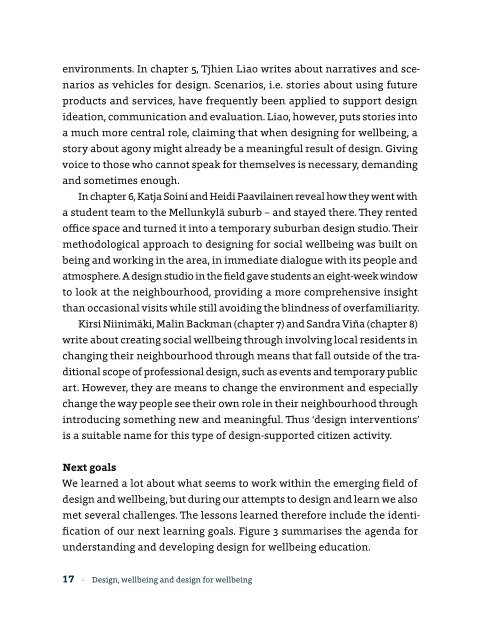Designing for wellbeing
Designing for wellbeing
Designing for wellbeing
Create successful ePaper yourself
Turn your PDF publications into a flip-book with our unique Google optimized e-Paper software.
environments. In chapter 5, Tjhien Liao writes about narratives and scenarios<br />
as vehicles <strong>for</strong> design. Scenarios, i.e. stories about using future<br />
products and services, have frequently been applied to support design<br />
ideation, communication and evaluation. Liao, however, puts stories into<br />
a much more central role, claiming that when designing <strong>for</strong> <strong>wellbeing</strong>, a<br />
story about agony might already be a meaningful result of design. Giving<br />
voice to those who cannot speak <strong>for</strong> themselves is necessary, demanding<br />
and sometimes enough.<br />
In chapter 6, Katja Soini and Heidi Paavilainen reveal how they went with<br />
a student team to the Mellunkylä suburb – and stayed there. They rented<br />
office space and turned it into a temporary suburban design studio. Their<br />
methodological approach to designing <strong>for</strong> social <strong>wellbeing</strong> was built on<br />
being and working in the area, in immediate dialogue with its people and<br />
atmosphere. A design studio in the field gave students an eight-week window<br />
to look at the neighbourhood, providing a more comprehensive insight<br />
than occasional visits while still avoiding the blindness of overfamiliarity.<br />
Kirsi Niinimäki, Malin Backman (chapter 7) and Sandra Viña (chapter 8)<br />
write about creating social <strong>wellbeing</strong> through involving local residents in<br />
changing their neighbourhood through means that fall outside of the traditional<br />
scope of professional design, such as events and temporary public<br />
art. However, they are means to change the environment and especially<br />
change the way people see their own role in their neighbourhood through<br />
introducing something new and meaningful. Thus ‘design interventions’<br />
is a suitable name <strong>for</strong> this type of design-supported citizen activity.<br />
Next goals<br />
We learned a lot about what seems to work within the emerging field of<br />
design and <strong>wellbeing</strong>, but during our attempts to design and learn we also<br />
met several challenges. The lessons learned there<strong>for</strong>e include the identification<br />
of our next learning goals. Figure 3 summarises the agenda <strong>for</strong><br />
understanding and developing design <strong>for</strong> <strong>wellbeing</strong> education.<br />
17 · Design, <strong>wellbeing</strong> and design <strong>for</strong> <strong>wellbeing</strong>
















